
A marsh is a wetland that is dominated by herbaceous rather than woody plant species. Marshes can often be found at the edges of lakes and streams, where they form a transition between the aquatic and terrestrial ecosystems. They are often dominated by grasses, rushes or reeds. If woody plants are present they tend to be low-growing shrubs, and then sometimes called carrs. This form of vegetation is what differentiates marshes from other types of wetland such as swamps, which are dominated by trees, and mires, which are wetlands that have accumulated deposits of acidic peat.
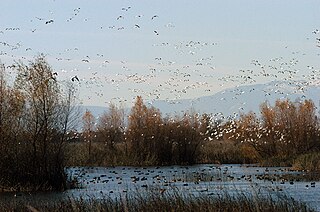
The California Central Valley grasslands is a temperate grasslands, savannas, and shrublands ecoregion in California's Central Valley. It a diverse ecoregion containing areas of desert grassland, prairie, savanna, riparian forest, marsh, several types of seasonal vernal pools, and large lakes such as now-dry Tulare Lake, Buena Vista Lake, and Kern Lake.

Vernal pools, also called vernal ponds or ephemeral pools, are seasonal pools of water that provide habitat for distinctive plants and animals. They are considered to be a distinctive type of wetland usually devoid of fish, and thus allow the safe development of natal amphibian and insect species unable to withstand competition or predation by fish. Certain tropical fish lineages have however adapted to this habitat specifically.

Mima mounds are low, flattened, circular to oval, domelike, natural mounds that are composed of loose, unstratified, often gravelly sediment that is an overthickened A horizon. These mounds range in diameter from 3 to more than 50 m; in height 30 cm to greater than 2 m; and in density from several to greater than 50 mounds per hectare, at times forming conspicuous natural patterns. Mima mounds can be seen at the Mima Mounds Natural Area Preserve in Washington state.

Limnanthes vinculans, the Sebastopol meadowfoam, is an endangered species of meadowfoam found only in the Laguna de Santa Rosa in Sonoma County, California, United States and an area slightly to the south in the Americano Creek and Washoe Creek watersheds. The name vinculans derives from the Latin root vinculum, meaning "a bond, a cord." The specific epithet vinculans means linking or bonding, in reference to the sharing of some characters of L. vinculans with L. douglasii (R.Br) and L. bakeri.

The Fairfield Osborn Preserve is a 450-acre nature reserve situated on the northwest flank of Sonoma Mountain in Sonoma County, California. There are eight plant communities within the property, oak woodland being the dominant type. Other communities include chaparral, Douglas fir woodland, native Bunch grass, freshwater marsh, vernal pool, pond and riparian woodland. The flora is extremely diverse including many native trees, shrubs, wildflowers, grasses, lichens and mosses. A diverse fauna inhabits this area including black-tailed deer, coyote, bobcat and an occasional mountain lion; moreover, there are abundant avifauna, amphibians, reptiles and insects.
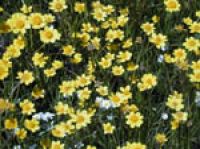
Lasthenia conjugens, commonly known as Contra Costa goldfields, is an endangered species of wildflower endemic to a limited range within the San Francisco Bay Area of the state of California, USA. Specifically this rare species occurs in Napa, Santa Barbara, Solano, Contra Costa, Santa Clara, Monterey and Alameda Counties. This annual herb typically flowers from March through June, and its colonies grow in vernal pool habitats at elevations not exceeding 100 meters above sea level. The Jepson Manual notes that the present distribution is limited to the deltaic Sacramento Valley, principally Napa and Solano Counties, but the historic range of L. conjugens is known to be significantly wider. In any case, historically the range has included parts of the North Coast, Sacramento Valley, and San Francisco Bay Area as well as the South Coast. Alternatively and less frequently this taxon has been referred to as Baeria fremontii var. conjugens.
The midvalley fairy shrimp, Branchinecta mesovallensis, is a small freshwater crustacean in the Branchinectidae family endemic to shallow ephemeral pools near the middle of California's Central Valley. These vernal pool ecosystems are home to other unique organisms adapted to the ephemeral nature of the water cycle in the pools in California's mediterranean climate.

The Yolo Bypass Wildlife Area is located within the Yolo Bypass in Yolo County, California. The wildlife area is managed by the California Department of Fish and Wildlife with the intent of restoring and managing a variety of wildlife habitats in the Yolo Basin, a natural basin in the north part of the Sacramento-San Joaquin River Delta. The creation of the wildlife area was spearheaded by the Yolo Basin Foundation. The California Department of Fish and Wildlife and Yolo Basin Foundation are the core partners in the operation of this unique community resource. Located at 38.550515°N 121.626291°W

The Loch Lomond Vernal Pool Ecological Reserve is a nature reserve of 8.22 acres (33,300 m2) in the community of Loch Lomond in Lake County, California. It is one of 119 ecological reserves managed by the California Department of Fish and Game (CDFG). The ecological reserve system was authorized by the state legislature in 1968 for the purpose of conservation and protection of rare plants, animals and habitats.

Orcuttia tenuis, the slender Orcutt grass, is a species of grass which is endemic to northern California.
The San Luis National Wildlife Refuge Complex is located in the northern San Joaquin Valley, within Merced County and Stanislaus County of California. The complex, with four federal National Wildlife Refuges, is managed by the U.S Fish & Wildlife Service.

Tuctoria is a genus of three species of grass in the family Poaceae. Spiralgrass is a common name for plants in this genus. These are bunchgrass species that are found in vernal pools of central California and Baja California, Mexico. The plants are annuals that germinate under water in the spring and grow submerged for weeks. After the pools dry down, the grasses initiate a new set of foliage that lasts for one to two months until flowering and fruiting are complete.

Orcuttia is a genus of grass in the family Poaceae. Plants grow up to 20 cm (8 in) tall, usually with many stems emerging from the base of the plant, and forming a tuft. The spikelets are several-flowered, with reduced upper florets. The lemma tips have between two and five teeth.
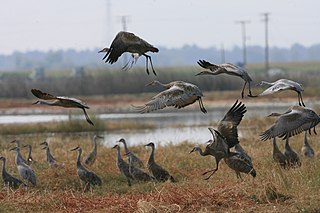
The Merced National Wildlife Refuge encompasses 10,262 acres (41.53 km2) of wetlands, native grasslands, vernal pools, and riparian areas in California. It was established in 1951 under the Lea Act to attract wintering waterfowl from adjacent farmland where their foraging was causing crop damage. In the last few decades, changes in agricultural practices and refuge management have reduced these wildlife/crop issues.

Navarretia cotulifolia is a species of flowering plant in the phlox family known by the common name cotulaleaf pincushionplant, or cotula navarretia.

Navarretia fossalis is a rare species of flowering plant in the phlox family known by the common name spreading navarretia.

Orcuttia californica is a rare species of grass known by the common name California Orcutt grass.
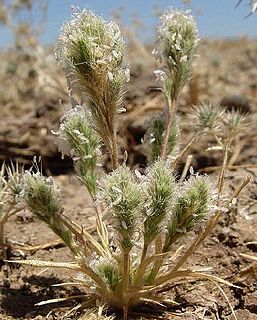
Orcuttia viscida is a rare species of grass known by the common name Sacramento Orcutt grass.
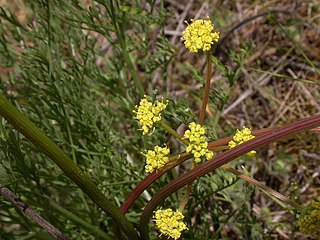
Lomatium cookii is a rare species of flowering plant in the carrot family known by the common names Cook's lomatium and agate desertparsley. It is endemic to Oregon in the United States, where it grows in only two valleys. It is a federally listed endangered species.




















